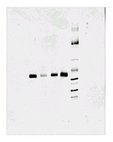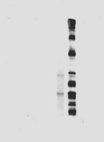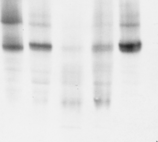ibt – immunological and biochemical testsystems GmbH: innovative tools for functional proteomics are our target!
Application Note IGF004: Biotinylated (Biotin labeled) IGF-I, IGF-II and analogs
Biotinylated IGF´s and analogs from IBT GmbH (formerly A. F. Schuetzdeller Biochemicals, AFSBIO) have been the first, that have been commercially available and our non-radioactive western ligand blotting kits have been the first on the market.
Advantages of ibt´s Biotinylation Technology:
We have developped our own biotinylation technology for IGF´s, that is different from the published methods. Our technology permits biotinylation without loss of activity:
Biotinylated IGF´s and analogs from ibt bind to native IGFBP´s and IGFBP´s on western blots!
Biotinylated IGF´s and analogs from ibt bind to antibodies!
Biotinylated IGF´s from ibt bind to receptors, are internalized and transported through cell layers!
Biotinylated IGF´s from ibt are biologically active in-vitro and in-vivo!
Stability:
Though our biotinylated IGF´s are very stable in solution, we have shipped them in the past on dry ice, to ensure maximum activity for our customers. This has increased shipping cost, so we have decided to lyophilise our IGF´s. In this form we have kept them for three months at temperatures up to 35 °C without loss of activity. So they can be shipped now without dry ice at reduced freight cost.
For long term storage, we recommend to store them refrigerated after arrival. The reconstituted biotinylated IGF´s are stable for at least one year at a concentration of 20 µg/ml, if kept frozen at -20 °C, and at least for one month at 4 °C. We recommend to aliquot the reconstituted biotinylated IGF´s and to store them at a temperature of - 20 °C.
Potential uses for biotinylated IGF´s:
1. Cell Therapy and Tissue Engineering:
Davis et al. describe the use of a complex with biotinylated IGF-1 with streptavidin and biotinylated self-assembling peptides. IGF-1 from the complex activated Akt, decreased activation of caspase-3, and increased expression of cardiac troponin I in cardiomyocytes. The complex provided sustained IGF-1 delivery for 28 days in vivo in rat myocardium, decreased caspase-3 cleavage, increased the myocyte cross-sectional area, and improved systolic function after experimental myocardial infarction (Ref.1).
The use of biotinylated IGF´s in tissue engineering is subject of ongoing research projects.
2. Binding, internalization and transcytosis studies:
Examples of binding and internalization studies have been published in Ref. 3, 11, 12,13.
A paper on imternalisation and transcytosis of biotinylated IGF-I from ibt has been published by Nishijima etl al. (18).
3. Western-ligand blotting with biotinylated IGF-I, IGF-II and analogs:
We have tested our biotinylated IGF´s and analogs in western-ligand blotting. Chemiluminescent substrates as well as colorimetric ones have successfully been used. We also have developped our own buffer system, with buffers, that are stable for at least six months and give an excellent signal-to background ratio. Kits are available for human (bovine, sheep, donkey, pig, guinea pig, goat) IGFBP´s (16) and mouse/rat IGFBP´s (17) For price information see blotting kit section in our price list. Analogs with reduced affinity to IGFBP´s have also reduced affinities in our western-ligand blot system.
3.1 Western-ligand blots with biotinylated IGF-I and analogs.
Biotinylated IGF-I binds to all six IGFBP´s, but binds to IGFBP-6 very weakly. As an example the western-ligand blots for IGFBP.-2 and -6 are shown in Fig. 1 and 2. For all IGF-I analogs at least weak signals have been obtained with IGFBP-1 to -5, but no signals were observed with IGFBP-6.
Fig. 1: Western-ligand blot of IGFBP-2 using biotinylated IGF-I and analogs. Fifty nanograms of recombinant IGFBP-2 (from insect cells) have been applied per lane on 8 - 18 % SDS-PAGE gels (Amersham Pharmacia). The reagents of our western-ligand blotting kit have been used. The procedure was as described in the instructions of the kit, except that the biotinylated IGF´s have been used at a concentration of 200 ng/ml to demonstrate even the binding of analogs with low affinity. Incubation time with biotinylated ligands was two hours. Chemiluminescent substrate has been used in combination with a standard Polaroid film, type 667, with an exposure time of 10 seconds. The picture has been scanned and is shown inverted to improve the contrast.
From the right to the left: Biotinylated molecular weight markers, biotinylated IGF-I, biotinylated R3-IGF-I, biotinylated Long R3-IGF-I, biotinylated Des(1-3) IGF-I. (Cathode on top, anode at the bottom).
Fig. 2: Western-ligand blot of recombinant IGFBP-6 (from insect cells) using biotinylated IGF-I and analogs. Conditions as for Fig. 1., except, that the exposure time to the Polaroid film has been prolonged to 1 min.
From the right to the left: Biotinylated molecular weight markers, biotinylated IGF-I, biotinylated R3-IGF-I, biotinylated Long R3-IGF-I, biotinylated Des(1-3) IGF-I. The additional band at higher molecular weight is presumably a dimer, because the calculated molecular weight is two times the molecular weight of the monomer and both bands are also detected on immuno blots with our IGFBP-6 specific antibodies.
Higher molecular weight forms have also been observed for IGFBP-3 and -5.
3.2 Western-ligand blots with biotinylated IGF-II and analogs
Fig. 3: Western-ligand blot of IGFBP-2 using biotinylated IGF-II and analogs. Conditions as in Fig. 1.
From the right to the left: Biotinylated molecular weight markers, biotinylated IGF-II, biotinylated Leu27-IGF-II, biotinylated R6-IGF-II, biotinylated Des(1-6) IGF-II.
With the Des(1-6) analog a very low signal was visible on the original picture, but is not visible on the scanned picture.
Biotinylated IGF-II and analogs give at least weak signals with all six human IGFBP´s. The Des(1-6) analogue has the weakest signals. As with IGF-I multimeric forms have been detected with IGFBP-3, -5 and -6.
3.3 Western-ligand blots of type 1 and 2 IGF-receptor:
Examples of receptor Bining of biotinylated IGF-I and biotinylated IGF-II are shown in Ref.3 and 4. It has been demonstrated that the biotinylated human IGF-I and -II cross-react with receptor from other species.
3.4 Stripping ligand blots and reprobing with antibodies
Stripping of an immunoblot with Re-Blot Plus-strong stripping solution
of GE Healthcare, Piscataway, NJ and reprobing with antibodies is described in (20)
4. ELISA:
We have tested our biotinylated human IGF-I and IGF-II in a competitive ELISA format using our polyclonal antisera PAA1 and PAC1. Binding to the antibodies was not affected by biotinylation. An ELISA kit for IGF-I is available now (see IGF-I ELISA). Moreover, biotinylated IGF analogs have been successfully used in ELISA by our customers in human samples ans samples from other species as.e.g. sheep (5).
A time-resolved fluoroimmunoassy in flounder was developped by Tadashi Andoh (6). He reported, that the standard curve of flounder IGF-I was identical to Bream-IGF-I. Fish IGF´s can be biotinylated upon request.
5. Immunoprecipitation/chromatography of IGFBP´s:
We have used our biotinylated human IGF-I and IGF-II in immunoprecipitation experiments. Binding of biotinylated IGF´s to Streptavidin may also be used to prepare media for affinity chromatography in a column format.
Fig 4: Human serum has been acidified to pH 2.3 and neutralised in the presence of excess biotinylated IGF-I or IGF-II. The samples have been precipitated with Stretavidin-Agarose. After extensive washing the bound proteins were eluted with acetic acid. After neutralisation, samples have been used for western-ligand blotting following the instructions of our western-ligand blotting kit. In this experiment colorimetric staining has been used.
From the right to the left: biotinylated marker proteins, human serum, proteins precipitated with biotinylated IGF-I, proteins precipitated with biotinylated IGF-II.
An example of iIsolation of IGF-IRs by affinity chromatography using biotinylated IGF-I is shown in Ref.7
6. Cross-linking experiments:
We have started to develop methods using our biotinylated IGF´s for cross-linking experiments. The method is not fully developped, e.g. the washing procedure needs to be improved and the extraction procedure for proteins needs improvement, too. Preliminary results are available.
Fig. 5: From the left to the right:
Proteins cross-linked with biotinylated IGF-II
- K562
- U937
- Ovcar-3
- Hep G2
- MDA-MB231 cells.
The original picture was scanned and is shown inverted, to improve contrast. The most prominent band has a molecular weight of approximately 135 kDa.
Briefly, 10 7 cells each have been washed with phosphate buffered saline (PBS), spun down in a centrifuge, and 100 µl of PBS containing 200 ng of biotinylated IGF-II have been added. The cells were incubated at room temperature for 90 min. Then 10 µl of a 10 mM solution of DSS in DMSO have been added. After 60 min. incubation at 4 °C the cells have been washed with PBS and the weight of the cell pellet has been determined. Per mg of pellet 4 µl of electrophoresis buffer have been added. The samples have been mixed and incubated at 90 °C for three minutes. Then the samples have bee centrifuged and 10 µl of the clear supernatants have been subjected to electrophoresis. The proteins have been transferred to a 0.22 µm nitrocellulose membrane by capillary blotting. The membrane has been blocked with Blocking/Dilution buffer from our western-ligand blotting kit for 30 min at room temperature and incubated with a solution of 1 tablet of Streptavidin-Peroxidase complex in 100 ml for 1 hour at room temperature. Then the mebrane was washed three times for ten minutes, incubated with the chemiluminescent substrate for 2 min. and exposed to a Polaroid film type 667 for 5 seconds.
7. Immunohistochemistry:
We have started experiments with our biotinylated IGF´s for IHC with human cells fixed on slides. The results of histochemistry have not been examined systematically, but staining has been observed on the surface of the cells.
Examples for use of biotinylated IGF-I in IHC have been published by Verschure et. al. (8, 9).
8. Flow cytometry:
The use of Biotin-Des (1-3) IGF-I in flow cytometry has been reported by Xu et al. (10).
9. Signal transduction studies with Quantum dot labeled biotinylated IGF-I:
A new application of biotinylated IGF-I is described in an abstract presented at the Society for Endocrinology (14). The authors from the University developed a technique to track biotinylated IGF-I both in live and fixed placental tissue. They demonstrated, that biotinylated IGF-I bound to streptavidin-conjugated fluorescent nanocrystals bound to the cytotrophoblasts, was internalized and enhanced proliferation and survival.&nbs
10. Biotin IGF-I binds to members of the IGFBPrP/CCN Family of proteins:
The binding of biotinylated IGF-I to WISP 3 is described in an abstract from the Second International Workshop on the CCN Family of Genes (15).
References on the use of biotinylated IGF-I and -II:
1.) Michael E. Davis*, Patrick C. H. Hsieh*, Tomosaburo Takahashi*, Qing Song, Shuguang Zhang, Roger D. Kamm, Alan J. Grodzinsky, Piero Anversa, and Richard T. Lee*: Local myocardial insulin-like growth factor 1 (IGF-1) delivery with biotinylated peptide nanofibers improves cell therapy for myocardial infarction. PNAS | May 23, 2006 | vol. 103 | no. 21 | 8155-8160
Full text of the article: www.pnas.org/cgi/content/full/103/21/8155
2.) Padin-Iruegas et al.:Cardiac Progenitor Cells and Biotinylated Insulin-Like
Growth Factor-1 Nanofibers Improve Endogenous and Exogenous Myocardial Regeneration After Infarction. Circulation. 2009;120:876-887.
Link to Article:
http://circ.ahajournals.org/cgi/reprint/CIRCULATIONAHA.109.852285v1
3.) Bolos et al.: ORAL ADMINISTRATION OF A GSK3 INHIBITOR INCREASES BRAIN INSULIN-LIKE GROWTH FACTOR-I LEVELS. JBC Papers in Press. Published on March 29, 2010.
http://www.jbc.org/content/early/2010/03/29/jbc.M109.096594.full.pdf+html
4.) Suresh Koduru, Sivaramakrishna Yadavalli, Siva Kumar Nadimpalli: Mannose 6-phosphate Receptor (MPR 300) Proteins from Goat and Chicken Bind Human IGF-II. Published online:Biosci Rep (2006) 26:101–112.
Link to abstract:
http://www.springerlink.com/content/dj35048k148434x8/
5.) Altmann et. al.: The relationships between leptin concentrations and body fat reserves in lambs are reduced by short-term fasting.Journal of Animal Physiology and Animal Nutrition 2006, Vol. 90, issue 9-10, p407 - 413.
Link to Abstract:
http://www.ncbi.nlm.nih.gov/pubmed/16958798
6.) Andoh T.: Development of non-radioisotopic immunoassay systems for measuring flounder IGF-I. Zoolog Sci. 2005 Sep;22(9):1023-30.
7.) Maloney et. al.: An Anti-Insulin-like Growth Factor I Receptor Antibody That Is a Potent Inhibitor of Cancer Cell Proliferation. CANCER RESEARCH 63, 5073–5083, August 15, 2003.
Link to Article.
8.) Verschure et. al.: Histochemical analysis of insulin-like growth factor-1 binding sites in mouse normal and experimentally induced arthritic articular cartilage.
9.) Verschure et. al.: The contribution of quantitative confocal laser scanning microscopy in cartilage research: Chondrocyte insulin-like growth factor-1 receptors in health and pathology. Microscopy Research and Technique. Volume 37 Issue 4, Pages 285 - 298.
10) Xu et al.: Expression of functional insulin-like growth factor-1 receptor on lymphoid cell subsets of rats. Immunology 85(1995), 394-399.
11.) Linnell et al.: Real Time Kinetics of Insulin-like Growth Factor II (IGF-II) Interaction with the IGF-II/Mannose 6-Phosphate Receptor. J. Biol. Chem., Vol. 276, Issue 26, 23986-23991, June 29, 2001.
12.) Kalus et. al.:Structure of the IGF-binding domain of the insulin-like growth factor-binding protein-5 (IGFBP-5): implications for IGF and IGF-I receptor interactions. The EMBO Journal (1998) 17, 6558–6572.
13.) Prince et al.: Functional evaluation of novel soluble insulin-like growth factor (IGF)-II–specific ligand traps based on modified domain 11 of the human IGF2 receptor. Molecular Cancer Therapeutics 6, 607-617, February 1, 2007.
14.)Forbes K, Aplin J, Westwood M (2009): Quantum dot labelled IGF-I: a novel technique to study IGF-signal transduction in the human placenta. Presented at Society for Endocrinology BES 2009 16–19 March 2009, Harrogate, UK. Endocrine Abstracts (2009) 19 P109.
15.) Kleer et al.: Abstract 13: WISP3, A TUMOR SUPPRESSOR GENE OF
INFLAMMATORY BREAST CANCER BINDS TO IGF-I AND MAY MODULATE IGF SIGNALING.Abstracts from the Second International Workshop on the CCN Family of Genes.Mol Pathol. 2003 April; 56(2): 65–75.
http://www.ncbi.nlm.nih.gov/pmc/articles/PMC1187296/
16.) Pircher et al.: A new method for the purification of bioactive insulin-like growth factor-binding protein-3. Protein Expression and Purification 71 (2010) 160–167.
Link to Abstract:
http://www.sciencedirect.com/science?_ob=ArticleURL&_udi=B6WPJ-4YC80SN-2&_user=10&_coverDate=06%2F30%2F2010&_rdoc=1&_fmt=high&_orig=search&_sort=d&_docanchor=&view=c&_searchStrId=1428943115&_rerunOrigin=google&_acct=C000050221&_version=1&_urlVersion=0&_userid=10&md5=f7f1e043cbca904e86719b7143f20bf9
17.) Rehfeldt et al.: Increased fat mass, decreased myofiber size, and a shift to glycolytic muscle metabolism in adolescent male transgenic mice overexpressing IGFBP-2. Am J Physiol Endocrinol Metab 299: E287–E298, 2010.
Link to Abstract:
http://ajpendo.physiology.org/cgi/content/abstract/299/2/E287
18.) Nishijima et al.: Neuronal Activity Drives Localized Blood-Brain-Barrier Transport of Serum Insulin-like Growth Factor-I into the CNS. Neuron 67, 834–846, September 9, 2010.
Link to Article:
http://digital.csic.es/bitstream/10261/27623/1/NeuronCSICRepository.pdf
19.) Taferner et. al.:Purification and characterization of native human insulin-like growth factor binding protein-6. J. Cell Commun. Signal.2011.DOI 10.1007/s12079-011-0126-2.
Link to article:
http://www.springerlink.com/content/c42m052x144212n8/
20.) Swain et al.: High-yield bacterial expression and structural characterization of recombinant human insulin-like growth factor binding protein-2. Arch Biochem Biophys. 2010 Sep 15;501(2):195-200. Epub 2010 Jun 10.
Link to Abstract:
http://www.ncbi.nlm.nih.gov/pubmed/20541521
http://www.pubmedcentral.nih.gov/articlerender.fcgi?artid=1187296




